By Amanda Drane
July 18th, 2023
Steel oil well casings clawed like fingers out of the collapsing sinkhole in Daisetta before the fast-receding earth swallowed them. People in the onetime East Texas boomtown watched in awe as a gaping hole nearly the size of two football fields formed within a few hours.
The May 2008 sinkhole raised questions with few answers. Then, this past April, a new sinkhole formed just south of the original one.
More than a dozen old oil wells were within the footprint of the two sinkholes, yet whether or not they triggered the collapse remains unknown.
Rusted well-heads and uncapped holes still dot the earth around Daisetta, whose salt dome — a geological feature that carried the promise of oil — lured oilmen there a century ago. The Liberty County town lost its water well six years ago because of saltwater contamination that has yet to be explained. The town plans to drill a new water well, but it lacks the funds to study the threats that may lie beneath the surface.
Remnants of densely drilled oil fields are scattered across East Texas towns such as Daisetta and in areas just north and south of Houston’s Inner Loop. But how many threats lay beneath the surface are unknown.
The issues surrounding old wells — the surprise discovery of undocumented wells, the growing list of orphaned wells, the frequency with which old plugs fail and how damaging unplugged wells can be to public health and the environment — are poorly understood. Policy solutions and resources to support them are percolating but underfunded, leaving many to fend for themselves.
“There are 400 homes here,” said Cindy Burchfield, a town council member in Daisetta with many unanswered questions. “More than half of ’em are low income.”
The region’s geology likely predisposed the area to collapse, scientists said. But they also agreed orphaned wells likely played a role. Did the open holes allow water to travel deep beneath the surface and dissolve supporting layers below?
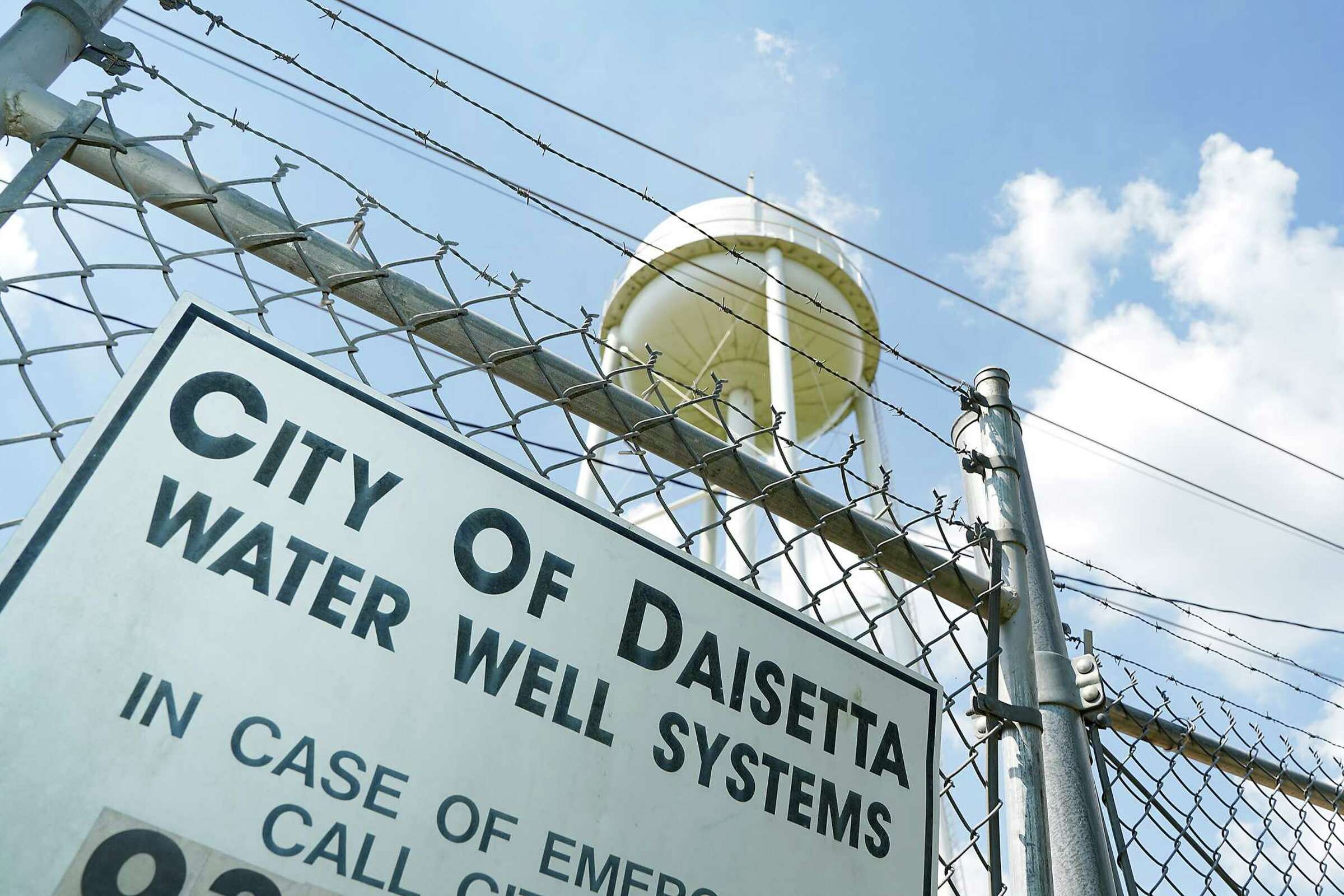

“That’s the question,” said geologist Richard Howe, who has studied Daisetta’s subsidence, or gradual sinking, since 2008.
Scientists have a shot at answering it, but it would require “lots of money” to bring in the equipment needed, he said.
These issues are coming into sharper focus as the energy industry dives into uncharted territory with carbon capture and storage, perceived by many as pivotal in the fight against climate change. Operators would remove climate-warming carbon dioxide from the air and pump it underground for storage, yet unplugged and leaking wells pose risks for the future of the emerging industry because they could allow carbon dioxide to travel back to the surface.
That, in turn, could undo climate benefits and endanger humans.
These issues are coming into sharper focus as the energy industry dives into uncharted territory with carbon capture and storage, perceived by many as pivotal in the fight against climate change. Operators would remove climate-warming carbon dioxide from the air and pump it underground for storage, yet unplugged and leaking wells pose risks for the future of the emerging industry because they could allow carbon dioxide to travel back to the surface.
That, in turn, could undo climate benefits and endanger humans.
Drone photo of a new sinkhole, left, in Daisetta, Texas, located close to a sink hole that fell in 2008, photographed on Friday, May 19, 2023 in Daisetta.
Elizabeth Conley/Staff photographer

The gas used in some oil fields to stimulate oil production has already found its way to the surface through old wells. In one notable case in southern Wyoming in 2016, carbon dioxide, methane and volatile organic compounds leaked into a school, forcing it to temporarily hold classes at a different site while several wells were plugged, according to a study by the Natural Resources Defense Council, an environmental advocacy group.
Compounding the problem, cement plugs could corrode when salt water and carbonic acid — the chemical result of carbon dioxide mixed with water — sloshes around underground. Even the slightest crack can accelerate corrosion, said Birol Dindoruk, endowed professor of petroleum engineering and chemical and biomolecular engineering at the University of Houston. He said lawmakers and regulators should have strict policies regarding how close carbon storage areas can be to old wells and there should be ongoing monitoring to stay on top of corrosion and leaks.
“Looking at these wells, evaluating them and taking care of them is extremely important for carbon sequestration,” Dindoruk said. “I think we need to do our homework.”
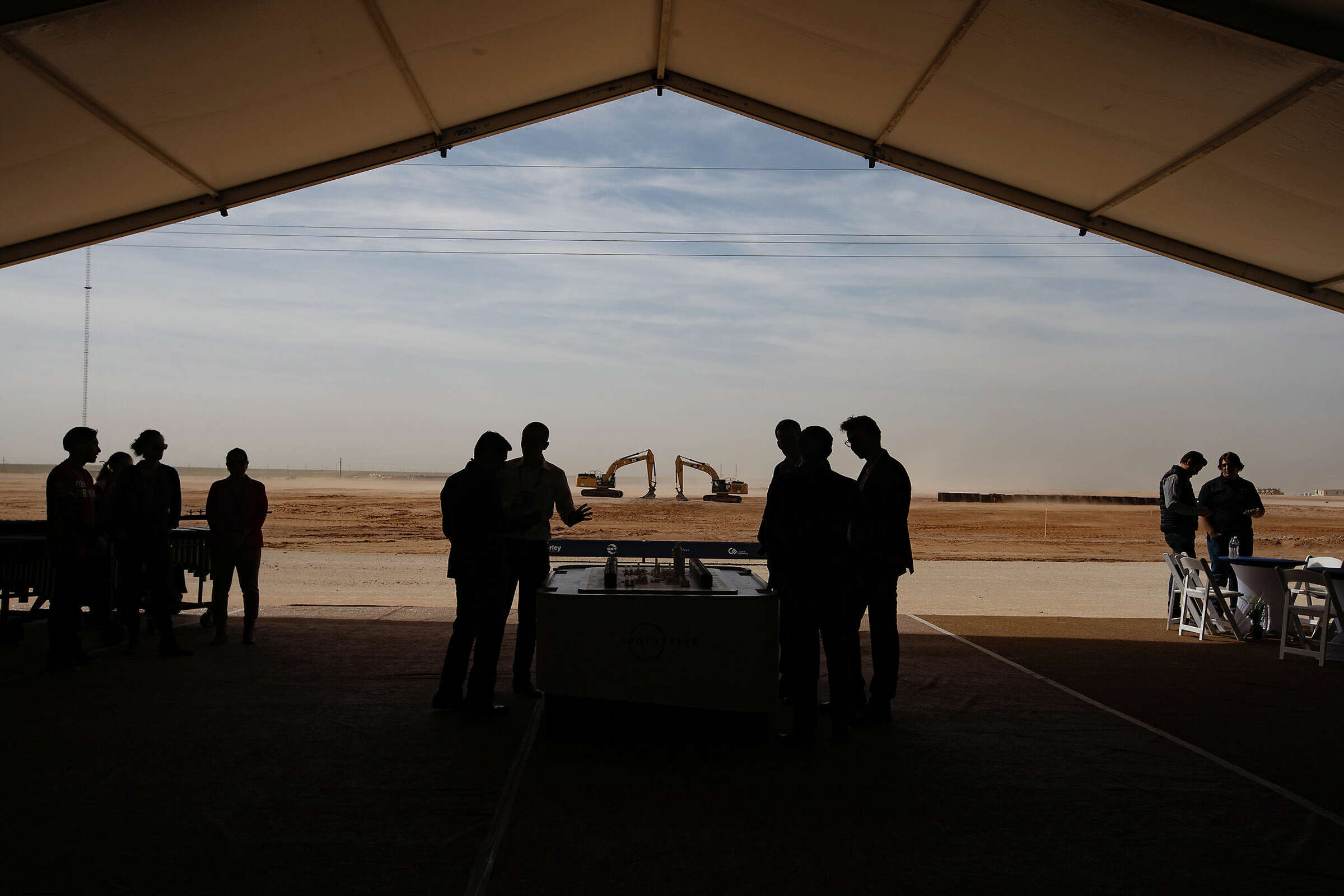
People gather for the groundbreaking for Oxy’s Direct Air Capture facility called “Stratos” in West Texas on Friday, April 28, 2023. The facility, which will be run by Oxy subsidiary 1PointFive, is expected to capture 500k tons of carbon dioxide per year and is the first of five hubs that the company is planning in Texas and Louisiana.
Elizabeth Conley/Staff photographer
Kitty Shivers Key, 78, remembers when oil money flowed into Daisetta. There were 10 beauty parlors in town when she was growing up in the 1950s, she recalled. Now, the town doesn’t even have a restaurant and the nearest grocery store is 15 miles away.
It confounds Key, a lifetime resident of the Daisetta area and informal town historian, that people in her community still lack basic information about what is going on under their community. She suggested the sinkhole be converted into a ticketed tourist destination to raise funds for more research.
What frustrates her most, though, is the truth at the bottom of the sinkhole likely isn’t as bad as it might seem.
“No matter what the doctor tells you,” she said, “it could not be as bad as you could imagine.”
Friday, May 19, 2023 in Daisetta.
Elizabeth Conley/Staff photographer
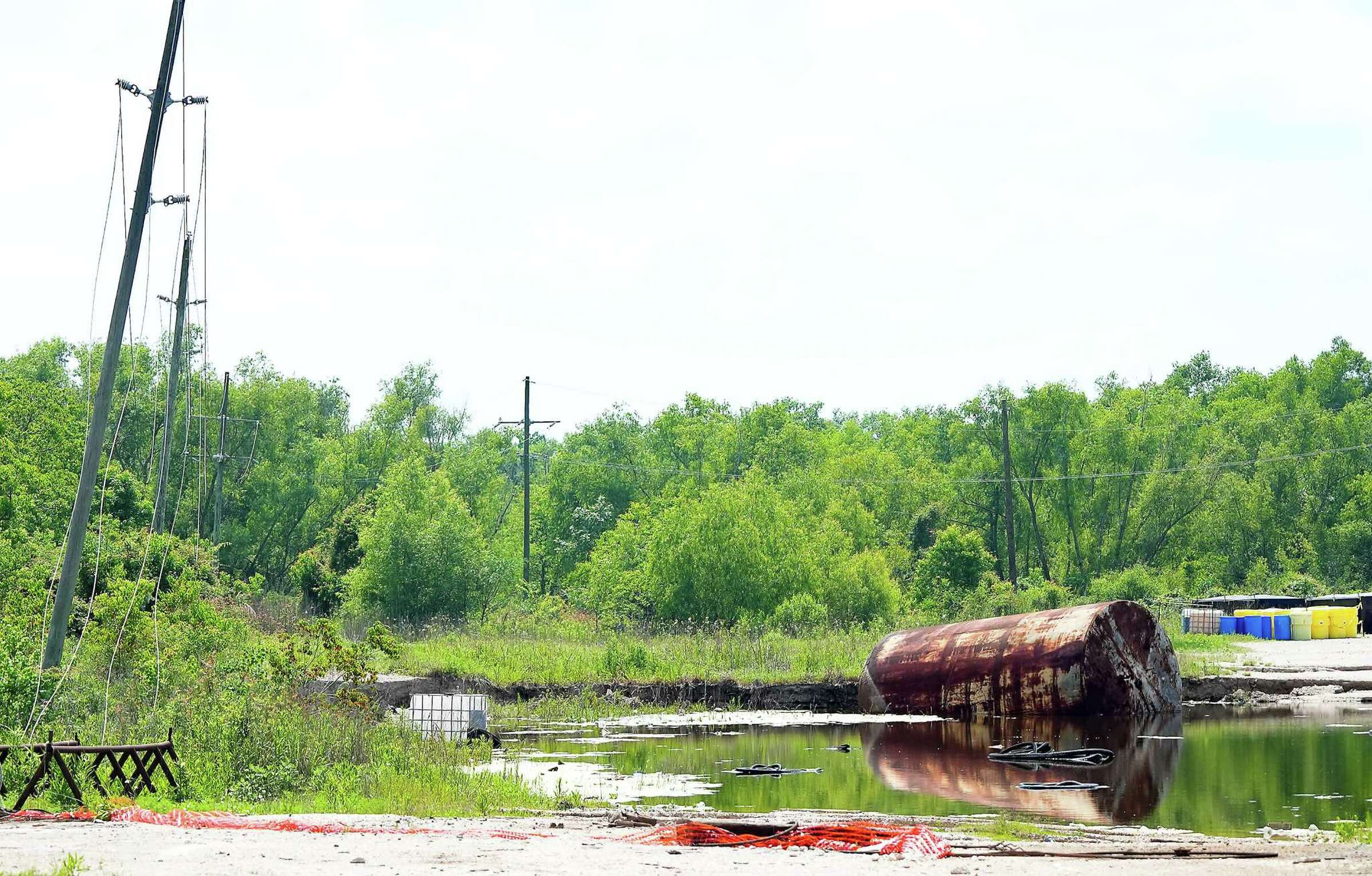
Transparency is important, she said. Key and her husband used to run a well-plugging firm. At one point, she said he headed to Austin in a failed attempt to convince the Legislature to require deeds to document the existence of wells on a property.
Transparency in real estate transactions is one of many failed policy pushes surrounding the issue of orphaned wells, said Adam Peltz, a director and senior attorney in the Environmental Defense Fund’s energy program. He said more work should be done to monitor wells, to quantify the cumulative emissions coming from unplugged wells and to study impacts of leaking wells on groundwater. Wells should be closely monitored to ensure they aren’t leaking, especially as carbon storage takes off.
“It’s one thing if you know about the orphan well. Then at least you can do something about it,” he said. “If you don’t know about it, surprise! You have a geyser.”
The single best way to address the overall problem of orphan wells, Peltz said, is to require companies to pay additional bonds for marginal wells — the low-producing wells often sold to small companies once an oil major has decided they are no longer worth keeping. These are the wells are most often orphaned when small firms go bankrupt or simply shut down and move on, sticking taxpayers with the cost of plugging.
Instead of allowing an oil major to sell the low-producing wells to a smaller firm without intervention, Peltz suggested regulators require a hefty bond as part of the transaction: $75,000 per well. If the firm plugs the well, the government gives the money back. If the firm doesn’t plug the well, the government has the money to do the work.

Schuyler Wight checks out a leaking well on his ranch on Tuesday, April 25, 2023 near Imperial.
Elizabeth Conley/Staff photographer
Texas already requires bonds from operators, but the amounts are small compared to the liability, Peltz said. Even Texas, “which has by far spent the most money on well closure,” is short on funds needed to fix the problem.
“The blanket bonds are not risk-tailored and the dollar amounts are small,” Peltz said, “so you have this problem where small operators who are not well-financed can have relatively small bonds for relatively large numbers of wells. And that puts state taxpayers at risk.”
Another route could be to incentivize well-plugging by offering companies carbon credits for plugging inactive wells, said Dan Arthur, president and chief engineer of Tulsa, Okla.-based ALL Consulting, who has decades of experience working with aging wells and the challenges they pose. “Those liabilities are so much that you’ve got to provide incentives to plug these wells.”
Roughly 80 percent of the orphaned wells are not creating problems, industry observers and scientists interviewed for the story said. But the ones creating problems tend to be significant and clustered in certain areas.
That’s why government-run well-plugging programs should also rethink the way they go about plugging wells in aging fields, Arthur said. Wells in a field should be evaluated and plugged as a single unit in the same way they were developed by oil producers. To continue doing it piecemeal can create more headaches, he said.
“Let’s say you have a little field that’s 10 wells. Plug one and it may cause another one to be a problem,” he said. “They don’t get developed one well at a time.”
Changing the strategy would require a thorough examination of orphaned wells. Doing it right would take more time than a single election cycle, he said.
A well plug rusting from produced water leakage, photographed on Tuesday, April 25, 2023 in West Texas.
Elizabeth Conley/Staff photographer
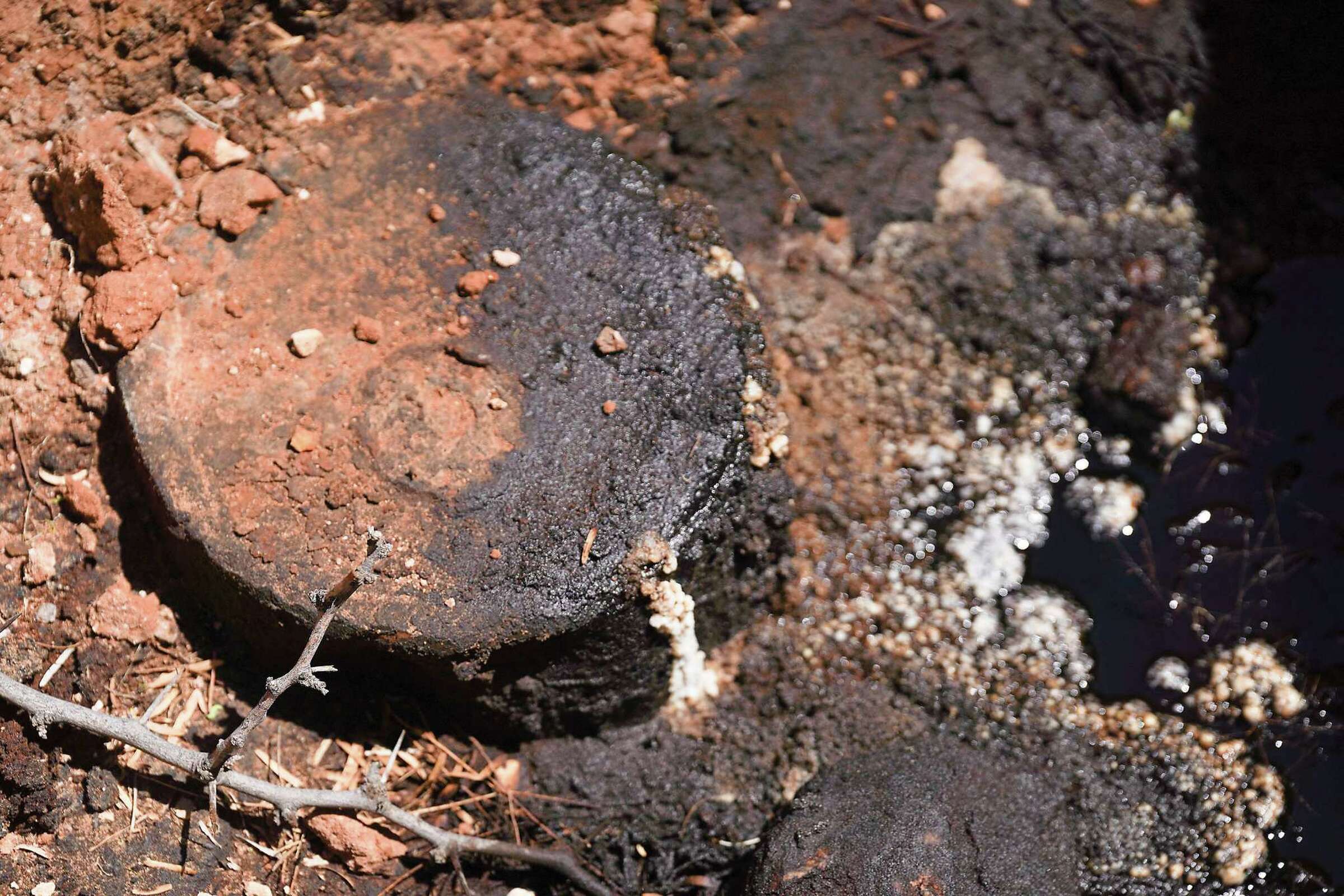
“They want to plug these for political gain. The states are under massive pressure,” he said, noting a one-year deadline to use initial disbursements of federal well-plugging funds that expire next year. “In an ideal world, you’d want to do these things, to identify the problem areas, the problem wells, check ‘em out.”
Certifying that the plug jobs are done correctly would be yet another step, he said. “That takes extra time and money.”
Ganesh Thakur, distinguished professor of petroleum engineering and director of energy industry partnerships at the University of Houston, agreed that the federal government should commission studies to identify and prioritize which wells should get plugged, and when.
“If these orphaned wells are identified properly and they are prioritized and we can focus on those which are the largest culprits, we can make big progress in this area,” he said.
Moving forward, he said, wells should be plugged to the highest standards, using the highest quality cement and steel, to preserve the environment and protect the future of the industry. Carbon dioxide is more corrosive than saltwater, oil and gas, and it can more freely move through cracks and leaks, he said. Only after the nation contends with its problem wells can carbon storage be a viable path forward in the fight against climate change.
“It is not the problem of only one operator. It is the problem of the state; it’s the problem of the public — you and me — and it’s the problem of the federal government,” he said. “We all need to work together. Because things are not going to become better with time. Things are going to get worse with time.”
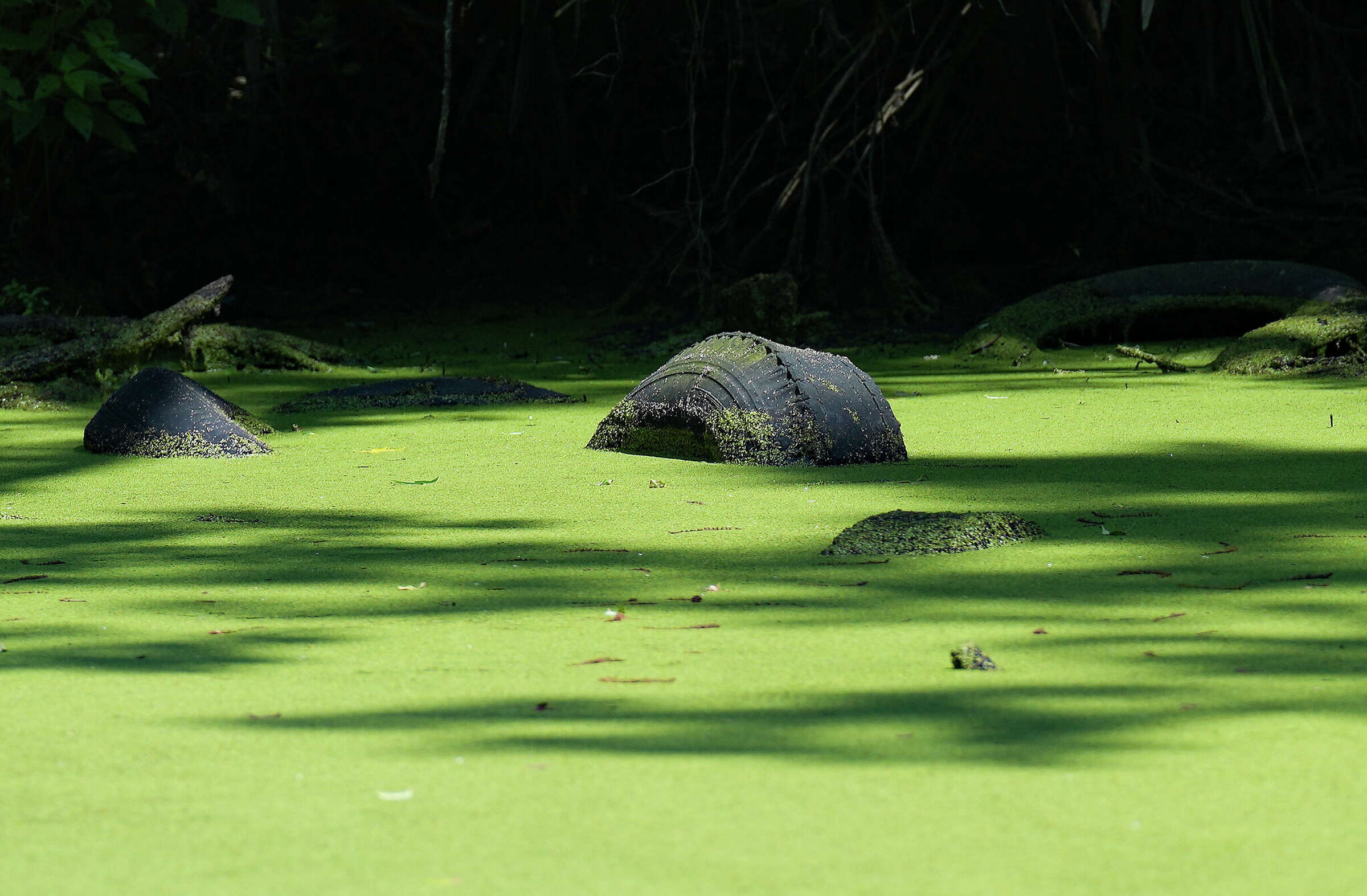
Tires dumped in an algae-covered pond created by a sink hole decades ago in Daisetta, Texas. Photographed on Friday, May 19, 2023 in Daisetta.
Elizabeth Conley/Staff photographer
This story is the third in a three-part series. Read Part 1 here and Part 2 here.